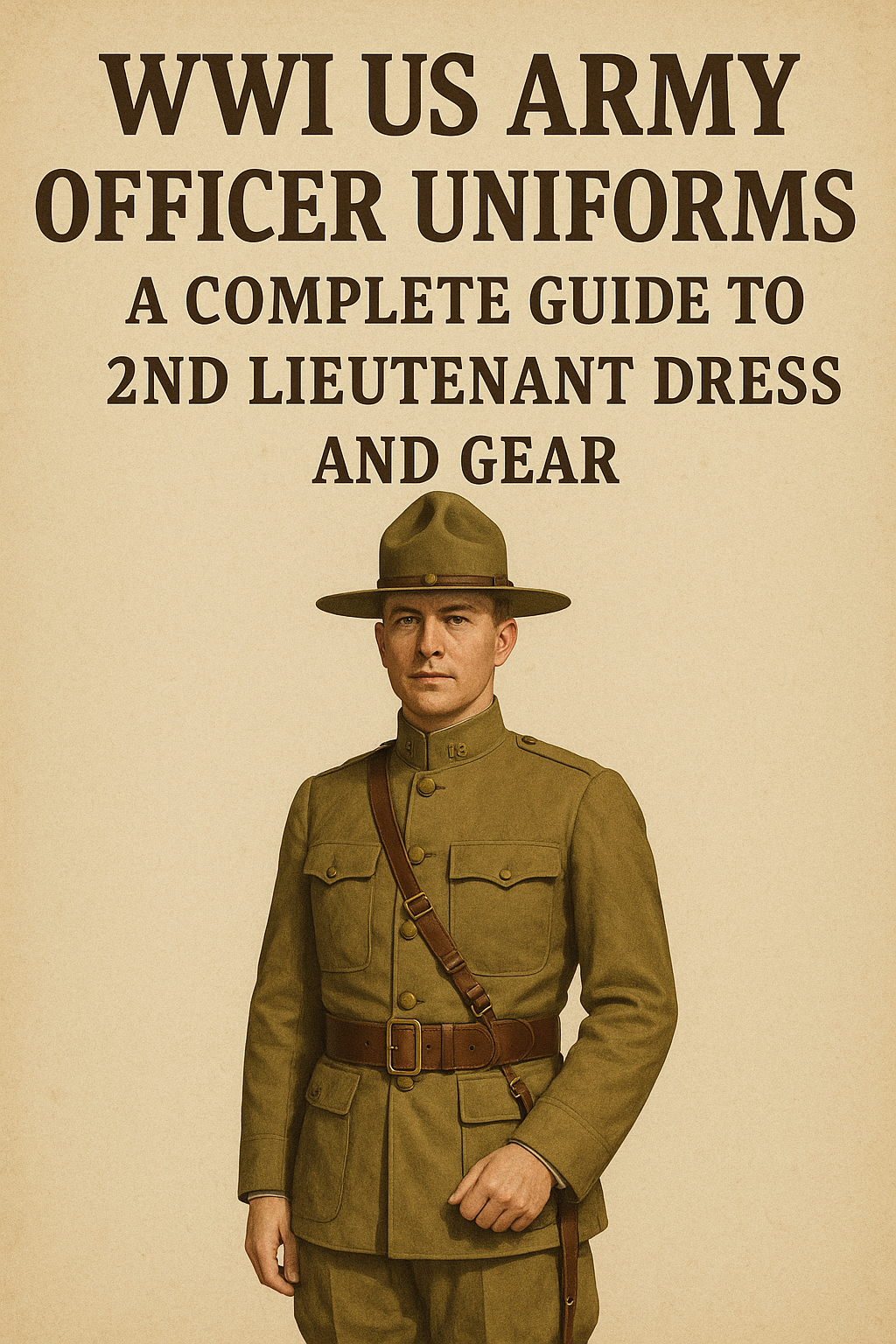
WWI US Army Officer Uniforms: A Complete Guide to 2nd Lieutenant Dress and Gear
Published on Jun 16, 2025
WWI US Army Officer Uniforms: An Introduction
World War I was a period of major transformation for the U.S. military—not only in combat tactics and technology but also in military apparel. The uniform of a U.S. Army officer during WWI wasn't just functional; it was a symbol of leadership, identity, and professionalism. From the humble 2nd lieutenant to seasoned field officers, what they wore communicated authority and allegiance.
The standard WWI officer uniform was both utilitarian and symbolic, and many of its components continue to influence modern military dress today. This article specifically highlights the features of a 2nd lieutenant’s uniform and contextualizes it within the broader landscape of American wartime attire.
1. 2nd Lieutenant Uniform: Foundation of the Officer Corps
Khaki Tunics and Field Jackets
The typical officer tunic, often made from wool or heavy cotton, followed the 1912 pattern known as the “Service Coat.” It was khaki or olive drab in color and featured a high standing collar, four front pockets, and epaulettes for rank identification. The tunic was paired with breeches, which were often tucked into tall leather boots or worn with puttees.
Rank Identification
A second lieutenant—being the lowest commissioned officer rank—was distinguished by a single gold bar placed on the shoulder straps. Additionally, insignia such as the “U.S.” collar disk and branch-specific symbols (like crossed rifles for infantry) were worn.
Shirts and Ties
Underneath the tunic, a tan wool or cotton shirt was worn, often accompanied by a matching khaki tie. The shirt was sometimes seen in casual or off-duty settings when the jacket was removed.
2. The Iconic Army Dress Uniform Hat
Campaign Hat
The iconic "Montana peak" campaign hat with its four symmetrical creases became symbolic of officers in the field. The hatband color denoted rank and branch—gold-and-black braid was commonly used for officers.
Visor (Service) Cap
In garrison or formal settings, officers often wore a service cap (visor cap), made from the same fabric as the tunic. It featured a rounded crown, stiff visor, and branch insignia in the center. This cap evolved into what is known today as the Army dress uniform hat.
3. Essential Accessories of the Officer Uniform
Sam Browne Belt
One of the most distinguishing accessories of an officer was the Sam Browne belt—a wide leather belt with a diagonal strap crossing over the right shoulder. It allowed the wearer to carry a pistol, sword, or map case and provided a smart, professional appearance.
Boots and Leggings
Leather riding boots were standard for officers, especially those in cavalry or artillery. Infantry officers often wore leather ankle boots with canvas puttees or wool leggings wrapped from ankle to knee for added support and protection.
Gloves and Outerwear
Officers frequently wore leather gloves, particularly when mounted. For colder months, long wool greatcoats in matching khaki hues were standard issue, complete with brass buttons and epaulettes.
4. Related Uniforms and Variations
While this article centers on WWI US Army officer attire, several other military uniforms of the same era share similar aesthetics and structure.
Female Marine Officer Uniform
Though women did not serve in combat roles during WWI, the U.S. Marine Corps introduced female service uniforms during the later stages of the war. These consisted of tailored coats, skirts (instead of breeches), and Marine insignia. Though not identical to the US Army officer uniforms, they shared the same khaki tones and formal cut.
Navy Chief Dress White (Choker Whites)
The Navy Chief Petty Officer uniform known as “choker whites” featured a white tunic with a high collar, gold buttons, and black shoulder boards. Though more formal and maritime in appearance, it shared the military crispness and ceremonial tone of Army dress uniforms.
5. Seasonal Adjustments and Climate Considerations
Summer Uniforms
In warmer climates, officers opted for lightweight cotton versions of the standard khaki tunic and trousers. These summer uniforms retained the same design but allowed for greater breathability and comfort.
Winter Garments
Winter uniforms featured thick wool layers, long coats, and sometimes fur-lined collars or gloves. Officers stationed in Europe’s harsh trenches found these essential for survival.
6. Wearing the Uniform: How to Recreate the Look Authentically
If you're a historical reenactor or collector looking to accurately represent a WWI US Army officer, here are a few key pointers:
- Start with the khaki tunic and breeches—ensure they follow the M1912 or M1917 pattern.
- Incorporate a Sam Browne belt—ideally leather, diagonally strapped.
- Choose the right hat—either a campaign hat for fieldwear or a visor cap for garrison and ceremonies.
- Don’t forget the boots—high leather boots or ankle boots with puttees are a must.
- Add insignia thoughtfully—a gold bar for 2nd lieutenant, U.S. collar disks, and branch symbols.
- Match with period-accurate accessories—leather gloves, greatcoats, and service chevrons can make all the difference.
7. Why These Uniforms Still Matter Today
WWI US Army officer uniforms hold more than historical value. They represent a turning point in American military history—a transition from Civil War styles to the modern battle dress. Reproducing or collecting these uniforms keeps that legacy alive. Whether worn at reenactments, displayed in museums, or offered as collectibles, they continue to symbolize courage, duty, and leadership.
The same attention to detail seen in WWI-era 2nd lieutenant uniforms echoes today in modern military attire. From fit and function to formality and pride, the legacy endures.
Conclusion
The WWI US Army officer uniform is more than a relic—it’s a living piece of military history. From the khaki tunic and Sam Browne belt to the iconic campaign hat and officer insignia, every element told a story of authority, readiness, and honor.
For enthusiasts, collectors, and reenactors alike, understanding this uniform in detail helps preserve its place in history. And for your website, Paddelaters.com, providing authentic replicas or accurate content about these garments ensures you not only educate but also engage and convert passionate audiences.
